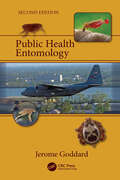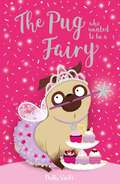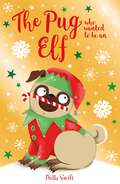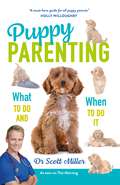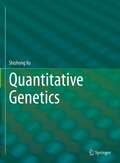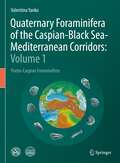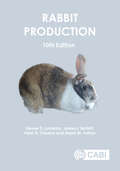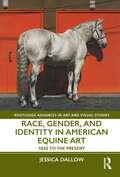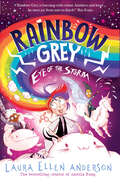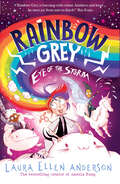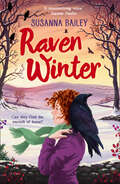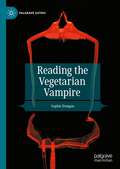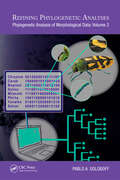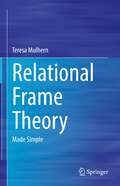- Table View
- List View
Public Health Entomology
by Jerome GoddardIn the struggle against vector-borne diseases, it is critical that we bridge the gap among vector control workers on the ground (practitioners), public health planners and administrators, and (academic) medical entomologists. This second edition of Public Health Entomology is designed to fit certificate courses in public health entomology offered by universities and U.S. Centers of Excellence. It comprehensively examines vector-borne disease prevention, surveillance, and control from a governmental and public health perspective with worldwide application.Divided into two sections, the book begins with a historical account of the early beginnings of pest control and public health. Next, it outlines the concepts, design, and implementation of a sound public health entomology program, including issues associated with pesticide use, FEMA and other disaster response entities, and an adverse, chemophobic public. The second section provides an overview of some of the most common public health pests that are found globally. Copious photos and line drawings accentuate the text, along with text boxes and sidebars. The new edition addresses "IPM and Alternative Control Methods" in each section, expands the Lyme disease section, and includes other new and emerging tick-borne diseases (TBD). It provides enhanced discussion of working with local political figures and jurisdictions, as well as partnerships with academia, and is generally more worldwide in scope. Author Jerome Goddard designed and implemented the vector control program along the Mississippi Gulf Coast after Hurricane Katrina. His ability to communicate his knowledge and experience to public health students, professionals, and the general public make this book an essential resource for preventing disease from these vector-borne threats.
The Pug Who Wanted to be a Fairy (The Pug Who Wanted to be... #6)
by Bella SwiftWag your tail if you believe in fairies! Peggy, the world's sweetest pug, is looking for a fairy to grant a very special wish.Peggy the pug is devastated when she finds out that her local park might shut down. Now where will she go for walks with Chloe, her best friend? Chloe plans a summer fair and a bake sale to save the park, but Peggy has a better idea. She just needs to find a fairy to grant her friend's wish! Her half-baked plan results in hilarious mishaps in this curly-wurly fairy tail with a super-sweet ending.You don't always need wings and a wand to work some magic . . .
The Pug Who Wanted to be an Elf (The Pug Who Wanted to... #8)
by Bella SwiftHave yourself a Peggy little Christmas! The world's favourite pug is back with a funny and festive story. Peggy and her family have won a dream winter holiday to Lapland! But sadly, Dad's work means that he can't go with them. Chloe is sad because their trip won't be as special if her whole family isn't together for Christmas. Peggy knows there's only one person who can help them - Santa Claus! Can she find a way to to become an elf and work some Christmas magic?
Puppy Parenting
by Dr Scott MillerGive your dog the best start to life with Dr Scott Miller's guide to raising the perfect puppy. All your questions are answered and concerns quelled with this friendly and authoritative guide to puppy care, which also contains features on puppy psychology and debunking popular myths. Follow Puppy Parenting's clear chronological format and learn what to expect at each stage of your pet's development, as well as how you can deal with behavioural and health issues. Case studies demonstrate real life problems and solutions and allow you to compare your experiences to those of other's, including Dr Miller's, as he raises his own troublesome terrier, Betty.
Quantitative Genetics
by Shizhong XuThe intended audience of this textbook are plant and animal breeders, upper-level undergraduate and graduate students in biological and agricultural science majors. Statisticians who are interested in understanding how statistical methods are applied to genetics and agriculture can benefit substantially by reading this book. One characteristic of this textbook is represented by three chapters of technical reviews for Mendelian genetics, population genetics and preliminary statistics, which are prerequisites for studying quantitative genetics. Numerous examples are provided to illustrate different methods of data analysis and estimation of genetic parameters. Along with each example of data analyses is the program code of SAS (statistical analysis system).
Quaternary Foraminifera of the Caspian-Black Sea-Mediterranean Corridors: Ponto-Caspian Foraminifera
by Valentina YankoThis handbook in two volumes offers a heretofore unavailable compilation of detailed information on foraminifera of the Caspian-Black Sea-Mediterranean Corridors (“CORRIDORS”), including their taxonomy, ecology, and applications in the study of Quaternary stratigraphy, paleogeographic reconstruction, and environmental stress. This subject is significant in light of the ongoing debates regarding the Flood Hypotheses because foraminifera can provide more information about many of the disputed questions. Foraminifera are highly reliable paleoenvironmental indicators, ubiquitous in marine environments, and taxonomically diverse, which gives them the potential for a wide range of biological responses to varied environmental factors. Their tests are readily preserved and can record evidence of environmental change through time, thus providing historical baseline data even in the absence of background studies. This book presents taxonomic descriptions for about 500 species and subspecies from the Black Sea, Sea of Azov, Caspian Sea, Aral Sea, Sea of Marmara, and the Eastern Mediterranean. This catalogue is supplemented by ecological remarks, stratigraphic distributions, paleogeography, and environmental/paleoenvironmental applications, including responses to environmental stress, e.g., river discharge, pollution by different contaminants, etc. The book will be useful to specialists in Quaternary history of the “CORRIDORS” as well as those in environmental monitoring and risk assessment. This handbook offers detailed taxonomic descriptions of foraminifera from the Black Sea, Caspian Sea, Sea of Azov, Aral Sea (in Volume 1) and Eastern Mediterranean and Sea of Marmara (in Volume 2).
Rabbit Production
by Steven Lukefahr James I McNitt Peter Robert Cheeke Nephi PattonRabbits are versatile animals, farmed for their meat and fur, as laboratory animals, and also as pets. This well-established book continues to provide an overview of domesticated rabbit production, covering topics such as breeding, husbandry, feeding and health. Now in its fully updated tenth edition, it includes an expanded consideration of important issues such as animal welfare and sustainable methods of production. With chapters relating specifically to meat production, pet rabbits, rabbit shows, and angora wool production, this new edition: - Includes new information on the latest methods of artificial insemination, estrous synchronization, embryo transfer, cloning and molecular genetics; - Tackles globally prevalent health issues such as enteritis complex (EC) rabbit enterocolitis (REC), and viral hemorrhagic disease; - Reviews up-to-the-minute developments such as the impact of the covid-19 pandemic on food production, as well as new projects addressing poverty alleviation and food security. Providing updates on worldwide production trends, figures and new feed additive products, this book is an essential resource for anyone involved in rabbit production - from novice to experienced breeders, veterinarians and industry professionals.
Race, Gender, and Identity in American Equine Art: 1832 to the Present (Routledge Advances in Art and Visual Studies)
by Jessica DallowThis book traces an evolution of equine and equestrian art in the United States over the last two centuries to counter conventional understandings of subjects that are deeply enmeshed in the traditions of elite English and European culture. In focusing on the construction of identity in painting and photography—of Blacks, women, and the animals themselves involved in horseracing, rodeo, and horse show competition—it illuminates the strategic and varying roles visual artists have played in producing cultural understandings of human-animal relationships. As the first book to offer a history of American equine and equestrian imagery, it shrinks the chasm of literature on the subject and illustrates the significance of the genre to the history of American art. This book further connects American equine and equestrian art to historical, theoretical, and philosophical analyses of animals and attests to how the horse endures as a vital, meaningful subject within the art world as well as culture at large. This book will be of interest to scholars in art history, American art, gender studies, race and ethnic studies, and animal studies.
Race, Gender, and Identity in American Equine Art: 1832 to the Present (Routledge Advances in Art and Visual Studies)
by Jessica DallowThis book traces an evolution of equine and equestrian art in the United States over the last two centuries to counter conventional understandings of subjects that are deeply enmeshed in the traditions of elite English and European culture. In focusing on the construction of identity in painting and photography—of Blacks, women, and the animals themselves involved in horseracing, rodeo, and horse show competition—it illuminates the strategic and varying roles visual artists have played in producing cultural understandings of human-animal relationships. As the first book to offer a history of American equine and equestrian imagery, it shrinks the chasm of literature on the subject and illustrates the significance of the genre to the history of American art. This book further connects American equine and equestrian art to historical, theoretical, and philosophical analyses of animals and attests to how the horse endures as a vital, meaningful subject within the art world as well as culture at large. This book will be of interest to scholars in art history, American art, gender studies, race and ethnic studies, and animal studies.
Rainbow Grey: Eye of the Storm (Rainbow Grey Series)
by Laura Ellen AndersonThe second book in a magical new series from best-selling author and illustrator, Laura Ellen Anderson!
Rainbow Grey: Eye of the Storm (Rainbow Grey Series)
by Laura Ellen AndersonThe second book in a magical new series from best-selling author and illustrator, Laura Ellen Anderson! This version is suitable for all devices including black and white eink readers and mobile phones.
Raven Winter
by Susanna BaileyThe brand new novel from the critically-acclaimed author of Snow Foal and Otters' Moon. Perfect for fans of Jacqueline Wilson and Gill Lewis.
Reading Slaughter: Abattoir Fictions, Space, and Empathy in Late Modernity (Palgrave Studies in Animals and Literature)
by Sune BorkfeltReading Slaughter: Abattoir Fictions, Space, and Empathy in Late Modernity examines literary depictions of slaughterhouses from the development of the industrial abattoir in the late nineteenth century to today. The book focuses on how increasing and ongoing isolation and concealment of slaughter from the surrounding society affects readings and depictions of slaughter and abattoirs in literature, and on the degree to which depictions of animals being slaughtered creates an avenue for empathic reactions in the reader or the opportunity for reflections on human-animal relations. Through chapters on abattoir fictions in relation to narrative empathy, anthropomorphism, urban spaces, rural spaces, human identities and horror fiction, Sune Borkfelt contributes to debates in literary animal studies, human-animal studies and beyond.
Reading the Vegetarian Vampire (Palgrave Gothic)
by Sophie DunganThis Pivot traces the rise of the so-called “vegetarian” vampire in popular culture and contemporary vampire fiction, while also exploring how the shift in the diet of (some) vampires, from human to animal or synthetic blood, responds to a growing ecological awareness that is rapidly reshaping our understanding of relations with others species. The book introduces the trope of the vegetarian vampire, as well as important critical contexts for its discussion: the Anthropocene, food studies, and the modern practice, politics and ideologies of vegetarianism. Drawing on references to recent historical contexts and developments in the genre more broadly, the book investigates the vegetarian vampire’s relationship to other more violent and monstrous forms of the vampire in popular twenty-first century horror cinema and television. Texts discussed include Interview with the Vampire, Buffy the Vampire Slayer, Twilight, The Vampire Diaries and True Blood. Reading the Vegetarian Vampire examines a new aspect of contemporary interest in considering vampire fiction.
Recent Advances in Animal Nutrition and Metabolism (Advances in Experimental Medicine and Biology #1354)
by Guoyao WuThis book covers hot topics in the nutrition and metabolism of terrestrial and aquatic animals, including the interorgan transport and utilization of water, minerals, amino acids, glucose, and fructose; the development of alternatives to in-feed antibiotics for animals (e.g., swine and poultry); and metabolic disorders (or diseases) resulting from nutrient deficiencies. It enables readers to understand the crucial roles of nutrients in the nutrition, growth, development, and health of animals. Such knowledge has important implications for humans. Readers will also learn from well-written chapters about the use of new genome-editing biotechnologies to generate animals (e.g., cows and swine) as bioreactors that can produce large amounts of pharmaceutical proteins and other molecules to improve the health and well-being of humans and other animals, as well as the growth and productivity of farm animals. Furthermore, the book provides useful information on the use of animals (e.g., cattle, swine, sheep, chickens, and fish) as models in biomedical research to prevent and treat human diseases, develop infant formulas, and improve the cardiovascular and metabolic health of offspring with prenatal growth restriction. Editor of this book is an internationally recognized expert in nutrition and metabolisms. He has about 40 years of experience with research and teaching at world-class universities in the subject matters. He has published more than 660 papers in peer-reviewed journals, 90 chapters in books, and authored two text/reference books, with a very high H-index of 127 and more than 66,000 citations in Google Scholar. This publication is a useful reference for nutrition and biomedical professionals, as well as undergraduate and graduate students in animal science, aquaculture, zoology, wildlife, veterinary medicine, biology, biochemistry, food science, nutrition, pharmacology, physiology, toxicology, and other related disciplines. In addition, all chapters provide general and specific references to nutrition and metabolism for researchers and practitioners in animal agriculture (including aquaculture), dietitians, animal and human medicines, and for government policy makers.
Red Leviathan: The Secret History of Soviet Whaling
by Ryan Tucker JonesA revealing and authoritative history that shows how Soviet whalers secretly helped nearly destroy endangered whale populations, while also contributing to the scientific understanding necessary for these creatures’ salvation. The Soviet Union killed over six hundred thousand whales in the twentieth century, many of them illegally and secretly. That catch helped bring many whale species to near extinction by the 1970s, and the impacts of this loss of life still ripple through today’s oceans. In this new account, based on formerly secret Soviet archives and interviews with ex-whalers, environmental historian Ryan Tucker Jones offers a complete history of the role the Soviet Union played in the whales’ destruction. As other countries—especially the United States, Great Britain, Japan, and Norway—expanded their pursuit of whales to all corners of the globe, Stalin determined that the Soviet Union needed to join the hunt. What followed was a spectacularly prodigious, and often wasteful, destruction of humpback, fin, sei, right, and sperm whales in the Antarctic and the North Pacific, done in knowing violation of the International Whaling Commission’s rules. Cold War intrigue encouraged this destruction, but, as Jones shows, there is a more complex history behind this tragic Soviet experiment. Jones compellingly describes the ultimate scientific irony: today’s cetacean studies benefited from Soviet whaling, as Russian scientists on whaling vessels made key breakthroughs in understanding whale natural history and behavior. And in a final twist, Red Leviathan reveals how the Soviet public began turning against their own country’s whaling industry, working in parallel with Western environmental organizations like Greenpeace to help end industrial whaling—not long before the world’s whales might have disappeared altogether.
Red Leviathan: The Secret History of Soviet Whaling
by Ryan Tucker JonesA revealing and authoritative history that shows how Soviet whalers secretly helped nearly destroy endangered whale populations, while also contributing to the scientific understanding necessary for these creatures’ salvation. The Soviet Union killed over six hundred thousand whales in the twentieth century, many of them illegally and secretly. That catch helped bring many whale species to near extinction by the 1970s, and the impacts of this loss of life still ripple through today’s oceans. In this new account, based on formerly secret Soviet archives and interviews with ex-whalers, environmental historian Ryan Tucker Jones offers a complete history of the role the Soviet Union played in the whales’ destruction. As other countries—especially the United States, Great Britain, Japan, and Norway—expanded their pursuit of whales to all corners of the globe, Stalin determined that the Soviet Union needed to join the hunt. What followed was a spectacularly prodigious, and often wasteful, destruction of humpback, fin, sei, right, and sperm whales in the Antarctic and the North Pacific, done in knowing violation of the International Whaling Commission’s rules. Cold War intrigue encouraged this destruction, but, as Jones shows, there is a more complex history behind this tragic Soviet experiment. Jones compellingly describes the ultimate scientific irony: today’s cetacean studies benefited from Soviet whaling, as Russian scientists on whaling vessels made key breakthroughs in understanding whale natural history and behavior. And in a final twist, Red Leviathan reveals how the Soviet public began turning against their own country’s whaling industry, working in parallel with Western environmental organizations like Greenpeace to help end industrial whaling—not long before the world’s whales might have disappeared altogether.
Refining Phylogenetic Analyses: Phylogenetic Analysis of Morphological Data: Volume 2 (Species and Systematics)
by Pablo A. GoloboffThis volume discusses the aspects of a phylogenetic analysis that go beyond basic calculation of most parsimonious trees. Practical application of all principles discussed is illustrated by reference to TNT, a freely available software package that can perform all the steps needed in a phylogenetic analysis. The first problem considered is how to summarize and compare multiple trees (including identification and handling wildcard taxa). Evaluation of the strength of support for groups, another critical component of any phylogenetic analysis, is given careful consideration. The different interpretations of measures of support are discussed and connected with alternative implementations. The book reviews rationales for estimating character reliability on the basis of homoplasy, with particular attention to morphological characters. The main methods for character weighting and their practical implementation, several of them unique to TNT, are discussed ad libitum. Also unique to TNT is the ability to directly analyze morphometric data (including landmarks), on the same footing as discrete characters. Finally, the scripting language of TNT is introduced. With scripting, it is possible to "program" TNT to create personalized routines and automate complex calculations, taking analyses to the next level and allowing exploration of new methods and ideas.Key Features Discusses the treatment of ambiguity in phylogenetic analyses in depth, for summarizing results or comparing trees Reviews literature on arguments and methods for weighting morphological characters and their practical application Describes theory and application of methods for evaluating strength of group support, based on either resampling or comparisons with suboptimal trees Discusses the use of morphometric characters in phylogenetic analysis Presents extensive information on commands and options of the TNT computer program, including the use and creation of scripts
Refining Phylogenetic Analyses: Phylogenetic Analysis of Morphological Data: Volume 2 (Species and Systematics)
by Pablo A. GoloboffThis volume discusses the aspects of a phylogenetic analysis that go beyond basic calculation of most parsimonious trees. Practical application of all principles discussed is illustrated by reference to TNT, a freely available software package that can perform all the steps needed in a phylogenetic analysis. The first problem considered is how to summarize and compare multiple trees (including identification and handling wildcard taxa). Evaluation of the strength of support for groups, another critical component of any phylogenetic analysis, is given careful consideration. The different interpretations of measures of support are discussed and connected with alternative implementations. The book reviews rationales for estimating character reliability on the basis of homoplasy, with particular attention to morphological characters. The main methods for character weighting and their practical implementation, several of them unique to TNT, are discussed ad libitum. Also unique to TNT is the ability to directly analyze morphometric data (including landmarks), on the same footing as discrete characters. Finally, the scripting language of TNT is introduced. With scripting, it is possible to "program" TNT to create personalized routines and automate complex calculations, taking analyses to the next level and allowing exploration of new methods and ideas.Key Features Discusses the treatment of ambiguity in phylogenetic analyses in depth, for summarizing results or comparing trees Reviews literature on arguments and methods for weighting morphological characters and their practical application Describes theory and application of methods for evaluating strength of group support, based on either resampling or comparisons with suboptimal trees Discusses the use of morphometric characters in phylogenetic analysis Presents extensive information on commands and options of the TNT computer program, including the use and creation of scripts
Reindeer Hunters of the Ice Age in Europe: Economy, Ecology, and the Annual Nomadic Cycle
by Laure FontanaThis book undertakes a thorough study of Reindeer in the Upper Pleniglacial and Tardiglacial societies in France. It addresses two main topics – the economy of animal resources within the societies and the exploitation of Reindeer organized within the annual cycle, in terms of space and time, between 30,000 and 14,000 cal BP in France. The author proposes an analysis and hypothesis regarding the economy of animal resources and the nomadic cycle of the last Paleolithic hunter-gatherer societies, in order to identify a “Reindeer system.”The author discusses the relationship between Reindeer and human mobility and offers some conclusions regarding the annual cycles of nomadism. The volume scrutinizes the distinct eco systems in three regions and its effects on the movements of both human and animal. This book is of interest to zooarchaeologists and prehistorians.
Reindeer Husbandry and Global Environmental Change: Pastoralism in Fennoscandia (Earthscan Studies in Natural Resource Management)
by Tim Horstkotte Øystein Holand Jouko Kumpula Jon MoenThis volume offers a holistic understanding of the environmental and societal challenges that affect reindeer husbandry in Fennoscandia today. Reindeer husbandry is a livelihood with a long traditional heritage and cultural importance. Like many other pastoral societies, reindeer herders are confronted with significant challenges. Covering Norway, Sweden and Finland – three countries with many differences and similarities – this volume examines how reindeer husbandry is affected by and responds to global environmental change and resource extraction in boreal and arctic social-ecological systems. Beginning with an historical overview of reindeer husbandry, the volume analyses the realities of the present from different perspectives and disciplines. Genetics, behavioural ecology of reindeer, other forms of land use, pastoralists’ norms and knowledge, bio-economy and governance structures all set the stage for the complex internal and externally imposed dynamics within reindeer husbandry. In-depth analyses are devoted to particularly urgent challenges, such as land-use conflicts, climate change and predation, identified as having a high potential to shape the future pathways of the pastoral identity and productivity. These futures, with their risks and opportunities, are explored in the final section, offering a synthesis of the comparative approach between the three countries that runs as a recurring theme through the book. With its richness and depth, this volume contributes significantly to the understanding of the substantial impacts on pastoralist communities in northernmost Europe today, while highlighting viable pathways to maintaining reindeer husbandry for the future. This book will be of great interest to students and scholars of both the natural and social sciences who work on natural resource management, global environmental change, pastoralism, ecology, social-ecological systems, rangeland management and Indigenous studies.
Reindeer Husbandry and Global Environmental Change: Pastoralism in Fennoscandia (Earthscan Studies in Natural Resource Management)
by Tim HorstkotteThis volume offers a holistic understanding of the environmental and societal challenges that affect reindeer husbandry in Fennoscandia today. Reindeer husbandry is a livelihood with a long traditional heritage and cultural importance. Like many other pastoral societies, reindeer herders are confronted with significant challenges. Covering Norway, Sweden and Finland – three countries with many differences and similarities – this volume examines how reindeer husbandry is affected by and responds to global environmental change and resource extraction in boreal and arctic social-ecological systems. Beginning with an historical overview of reindeer husbandry, the volume analyses the realities of the present from different perspectives and disciplines. Genetics, behavioural ecology of reindeer, other forms of land use, pastoralists’ norms and knowledge, bio-economy and governance structures all set the stage for the complex internal and externally imposed dynamics within reindeer husbandry. In-depth analyses are devoted to particularly urgent challenges, such as land-use conflicts, climate change and predation, identified as having a high potential to shape the future pathways of the pastoral identity and productivity. These futures, with their risks and opportunities, are explored in the final section, offering a synthesis of the comparative approach between the three countries that runs as a recurring theme through the book. With its richness and depth, this volume contributes significantly to the understanding of the substantial impacts on pastoralist communities in northernmost Europe today, while highlighting viable pathways to maintaining reindeer husbandry for the future. This book will be of great interest to students and scholars of both the natural and social sciences who work on natural resource management, global environmental change, pastoralism, ecology, social-ecological systems, rangeland management and Indigenous studies.
Relational Frame Theory: Made Simple
by Teresa MulhernRelational Frame Theory: What is it? Why is it important? How can I use it? This book dispels the confusion surrounding Relational Frame Theory and provides an easy-to-understand briefing of Relational Frame Theory and its’ components, with examples to enhance and ease understanding. Recent research has indicated that Relational Frame Theory may form the cornerstone of language and intelligence and this textbook integrates this information into an easily digestible format, considering the importance of each relational frame from coordination to analogy. Relational Frame Theory provides a potentially useful framework for teaching language and academic skills and the current textbook provides some examples of how to do this and offers some considerations for future research in this area. This book makes Relational Frame Theory easy to understand and, unlike previous books, assumes no prior knowledge of the theory amongst readers and clarifies some of the jargon used within this body of work. This book provides the most up-to-date outline of previous work within Relational Frame Theory and gives an overview of how this theory could be applied within psychology. To date, no previous book has attempted to integrate research, application and an easy-to-understand overview of the theory together – this book aims to integrate all of these aspects into one easily comprehensible guide. The current textbook is aimed towards graduate students and practitioners of applied behavior analysis. Given the proposed changes to the Behavior Analysis Certification Board which will focus more on Relational Frame Theory than in the past, a book of this nature will be helpful for those pursuing certification and may also be helpful for use within the applied field.
Remnants of Ancient Life: The New Science of Old Fossils
by Dale GreenwaltThe revolution in science that is transforming our understanding of extinct lifeWe used to think of fossils as being composed of nothing but rock and minerals, all molecular traces of life having vanished long ago. We were wrong. Remnants of Ancient Life reveals how the new science of ancient biomolecules—pigments, proteins, and DNA that once functioned in living organisms tens of millions of years ago—is opening a new window onto the evolution of life on Earth.Paleobiologists are now uncovering these ancient remnants in the fossil record with increasing frequency, shedding vital new light on long-extinct creatures and the lost world they inhabited. Dale Greenwalt is your guide to these astonishing breakthroughs. He explains how ancient biomolecules hold the secrets to how mammoths dealt with the bitter cold, what colors dinosaurs exhibited in mating displays, how ancient viruses evolved to become more dangerous, and much more. Each chapter discusses different types of biomolecules and the insights they provide about the physiology, behavior, and evolution of extinct organisms, many of which existed long before the age of dinosaurs.A marvelous adventure of discovery, Remnants of Ancient Life offers an unparalleled look at an emerging science that is transforming our picture of the remote past. You will never think of fossils in the same way again.
Remnants of Ancient Life: The New Science of Old Fossils
by Dale GreenwaltThe revolution in science that is transforming our understanding of extinct lifeWe used to think of fossils as being composed of nothing but rock and minerals, all molecular traces of life having vanished long ago. We were wrong. Remnants of Ancient Life reveals how the new science of ancient biomolecules—pigments, proteins, and DNA that once functioned in living organisms tens of millions of years ago—is opening a new window onto the evolution of life on Earth.Paleobiologists are now uncovering these ancient remnants in the fossil record with increasing frequency, shedding vital new light on long-extinct creatures and the lost world they inhabited. Dale Greenwalt is your guide to these astonishing breakthroughs. He explains how ancient biomolecules hold the secrets to how mammoths dealt with the bitter cold, what colors dinosaurs exhibited in mating displays, how ancient viruses evolved to become more dangerous, and much more. Each chapter discusses different types of biomolecules and the insights they provide about the physiology, behavior, and evolution of extinct organisms, many of which existed long before the age of dinosaurs.A marvelous adventure of discovery, Remnants of Ancient Life offers an unparalleled look at an emerging science that is transforming our picture of the remote past. You will never think of fossils in the same way again.
